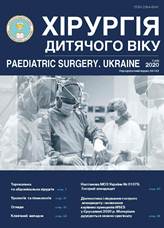Using prepucial mucous to cover neourethra in TIP urethroplasty: 4 years experience in a tertiary paediatric hospital of Bangladesh
DOI:
https://doi.org/10.15574/PS.2020.68.37Keywords:
Hypospadias, TIP urethroplasty, Prepucial mucosaAbstract
Background. Hypospadias has a wide spectrum of penile abnormality requiring surgical correction. Most of the cases are of anterior variety and the surgical technique depends on constructing a neo urethra. Snodgrass or Tubularized Incised Plate (TIP) urethroplasty is one of the most popular techniques of urethroplasty which depends on the existing healthy, adequate and intact urethral plate. Different tissues have been described to cover the neourethra as second layer in literature. In this study we modified the TIP urethroplasty by covering the neourethra with 2 layers of pedicled prepucial mucosa or Dartos flap.
Objective. To see the outcome of modified Snodgrass or TIP urethroplasty in anterior mid and proximal penile hypospadias.
Materials and method. Total 88 patients were operated by modified Snodgrass technique or modified TIP urethroplasty from January 2012 to July 2016. Coronal, subcoronal, distal penile, mid penile and proximal penile hypospadias were included in the study. Every patient underwent modified TIP urethroplasty and outcomes were assessed.
Results. The mean age of the patients were 28.34±14.98 months, ranges from 6.5 to 65 months. 9 (10.2%) patients of our series develop urethrocutaneous fistula, 5 (5.68%) patients develop meatal stenosis and 1 (1.1%) patient developed neourethral stricture.
Conclusion. TIP urethroplasty is a versatile method to correct penile hypospadias. Covering of the neourethra with prepucial mucosa secure the neourethral anastomosis.
References
Baskin LS, Ebbers MB. (2006). Hypospadias: Anatomy, etiology, and technique. J Pediatr Surg. 41: 463-472. https://doi.org/10.1016/j.jpedsurg.2005.11.059; PMid:16516617
Paulozzi L, Erickson D, Jackson. (1997). Hypospadias trends in two US surveillance systems. Pediatrics. 100: 831-834. https://doi.org/10.1542/peds.100.5.831; PMid:9346983
Paulozzi L. (1999). International trends in rates of hypospadias and cryptorchidism. Environ Health Perspect. 107: 297-302. https://doi.org/10.1289/ehp.99107297; PMid:10090709 PMCid:PMC1566511
Alkan M, Oguzkurt P, Ezer SS, Ince E, Hicsonmez A. (2008). Evaluation of the results of eccentric circummeatal-based flap with combined limited urethral mobilization technique for distal hypospadias repair. J Pediatr Urol. 4: 206-9. https://doi.org/10.1016/j.jpurol.2007.11.008; PMid:18631927
Hamdy H, Awadhi MA, Rasromani KH. (1999). Urethral mobilization andmeatal advancement: a surgical principle in hypospadias repair. Pediatr Surg Int. 15: 240-2. https://doi.org/10.1007/s003830050566; PMid:10370034
Jayanthi VR. (2003). The modified Snodgrass hypospadias repair: reducing the risk of fistula and meatal stenosis. J Urol. 170: 1603-1605. https://doi.org/10.1097/01.ju.0000085260.52825.73; PMid:14501672
Snodgrass W. (1994). Tubularized incised plate urethroplasty for distal hypospadias. J Urol. 151: 464-5. https://doi.org/10.1016/S0022-5347(17)34991-1
Retik AB, Borer JG. (1998). Primary and reoperative hypospadias repair with the Snodgrass technique. World J Urol.16:186-91. https://doi.org/10.1007/s003450050050; PMid:9666542
Holland AJ, Smith GH, Cass DT. (2000). Clinical review of the Snodgrass hypospadias repair. Aust NZ J Surg. 70: 597-600. https://doi.org/10.1046/j.1440-1622.2000.01906.x; PMid:10945555
Dayanc. M, Tan MO, Gokalp A, Yıldırım L, Peker AF. (2000). Tubularized incised plate urethroplasty for distal and mid-penile hypospadias. Eur Urol. 37: 102-5. https://doi.org/10.1159/000020108; PMid:10671794
Mehmet E, Gu.lay T, Serdar S. (2004). Tubularized Incised Plate Urethroplasty: 5 Years’ Experience. European Urology. 46: 655-659. https://doi.org/10.1016/j.eururo.2004.05.007; PMid:15474279
Snodgrass WT. (2005). Surgical Atlas Snodgrass technique for hypospadias repair, illustration by Stephan Spitzer. BJU international. 95: 683-693. https://doi.org/10.1111/j.1464-410X.2005.05384.x; PMid:15705110
Snodgrass W. (1999). Does tubularized incised plate hypospadias repair create neourethral strictures. J Urol. 162: 1159-61. https://doi.org/10.1097/00005392-199909000-00072; PMid:10458455
Elbakryl A. (1999). Tubularized incised plate urethroplasty: Is regular dilatation necessary for success? BJU Int. 84: 683-8. https://doi.org/10.1046/j.1464-410x.1999.00207.x; PMid:10510116
Lorenzo AJ, Snodgrass WT. (2002). Regular dilatation is unnecessary after tubularized-incised plate hypospadias repair. BJU Int. 89: 94-7. https://doi.org/10.1046/j.1464-410X.2002.02519.x
Elbakryl A. (2002). Further experience with the tubularizedincised urethral plate technique for hypospadias repair. BJU Int. 89: 291-4. https://doi.org/10.1046/j.1464-4096.2001.01525.x; PMid:11856113
Snodgrass WT, Nguyen MT. (2002). Current technique of tubularized incised plate hypospadias repair. Urology. 60: 157-62. https://doi.org/10.1016/S0090-4295(02)01620-5
Dhua AK, Agarwal S, Sinha S, Ratan SK. (2012, Mar). Soft tissue covers in hypospadias surgery: Is tunica vaginalis better than dartos flap? JIAPS. 17(1): 16-9. https://doi.org/10.4103/0971-9261.91080; PMid:22279358 PMCid:PMC3263032
Baskin LS. (2010). Hypospadias. in: JA O'Neil, MI Rowe, JA Grossfield, EW Fankalsrud, AG Coran, editors.Pediatric Surgery, 7th edn. Missouri: Mosby year book: 1531-1553. https://doi.org/10.1016/B978-0-323-07255-7.00121-5
Downloads
Published
Issue
Section
License
The policy of the Journal “PAEDIATRIC SURGERY. UKRAINE” is compatible with the vast majority of funders' of open access and self-archiving policies. The journal provides immediate open access route being convinced that everyone – not only scientists - can benefit from research results, and publishes articles exclusively under open access distribution, with a Creative Commons Attribution-Noncommercial 4.0 international license(СС BY-NC).
Authors transfer the copyright to the Journal “PAEDIATRIC SURGERY.UKRAINE” when the manuscript is accepted for publication. Authors declare that this manuscript has not been published nor is under simultaneous consideration for publication elsewhere. After publication, the articles become freely available on-line to the public.
Readers have the right to use, distribute, and reproduce articles in any medium, provided the articles and the journal are properly cited.
The use of published materials for commercial purposes is strongly prohibited.

